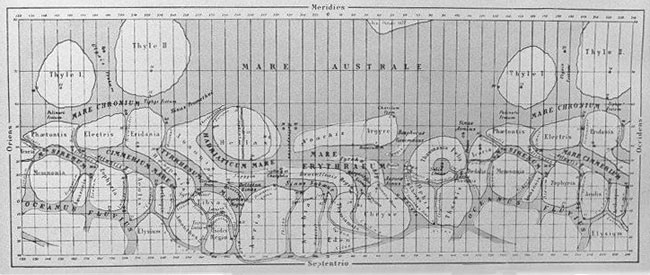Schiaparelli approached Mars with the tools of the surveyor and micrometrically determined sixty-two points on the Martian surface. From these positions and a series of delicately nuanced drawings he plotted a map. (The list of his micrometrically determined points is given in his Memoria Prima, published in 1878. For some strange reason, it was not translated into English for over a century. One of the authors (W.S.), finally decided to remedy the deficiency in 1994, and the translation was published as: "Astronomical and Physical Observations of the Axis of Rotation and the Topography of the Planet Mars: First Memoir, 1877-1878 (San Francisco: A.L.P.O. Monograph Number 5).

The Italian astronomer was not the first astronomer to map Mars. A number of previous astronomers had done so, beginning with the Germans, Beer and Madler, in the 1830s. But Schiaparelli's map was an order of magnitude more precise than any before it and loaded with rafts of new detail. In retrospect, his decision to approach Mars "with micrometric precision" was decisive. It led him and other astronomers to concentrate specifically on the most well-defined and unambiguous points on the surface: the caret-like projections of the dark areas and the dark spots - the "lakes" or "oases" as they were variously named. As soon as one attends chiefly to these hard and sharp points, one begins to elicit the connect-the-dot propensity of the eye-brain-hand system.
Schiaparelli created a new way of looking at Mars. He decided to scrap previous systems of nomenclature giving features the names of still-living astronomers - Kaiser Sea, Lockyer Land, De la Rue Sea, Dawes's Forked Bay-- and make a fresh start. As a man deeply immersed in literature, he draped biblical and classical names around the planet and transformed Mars into a world of romance. Among the names he chose were: Mare Sirenum (the Sea of Sirens), Solis Lacus (the Lake of the Sun), Tharsis, Atlantis, Eden, and Utopia, all of which have lived on ever since in the rich lore of the planet, a lore which his names did so much to create. "Even to look at those names on the map," remarks Arthur C. Clarke in his 1951 novel The Sands of Mars, "was to set the blood pounding."
Some of the names were wonderfully inspired and indeed prescient - Nix Olympica, the Snows of Olympus, is a case in point. Schiaparelli chose that name for the tiny bright patch which has proved to be the most towering shield volcano in the Solar System.
In addition to introducing a fabulous nomenclature for Mars which brought a new level of precision to observations, Schiaparelli's map was the first to show the streaky features he called canali, the Italian word for grooves but immediately translated (or rather mistranslated) into English as "canals." And canals they shall always be.